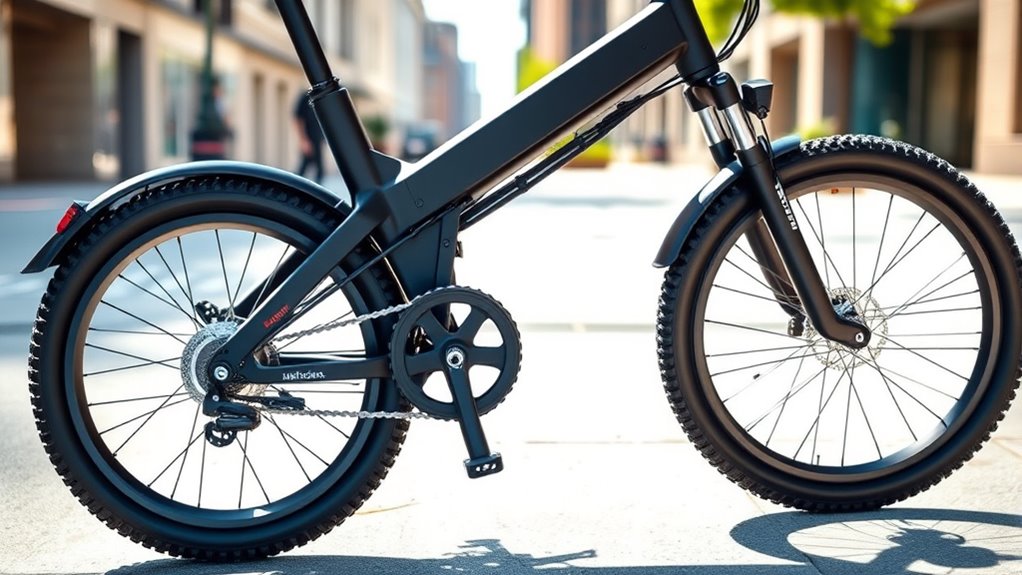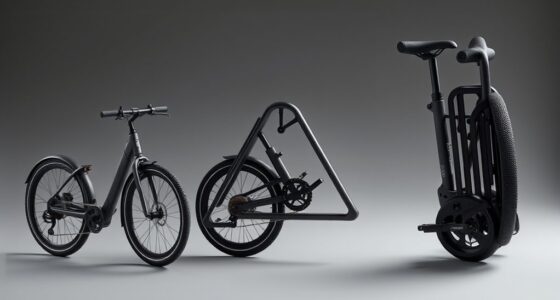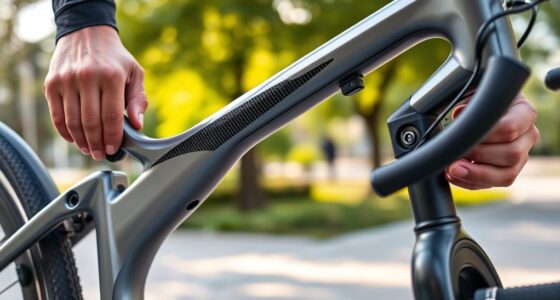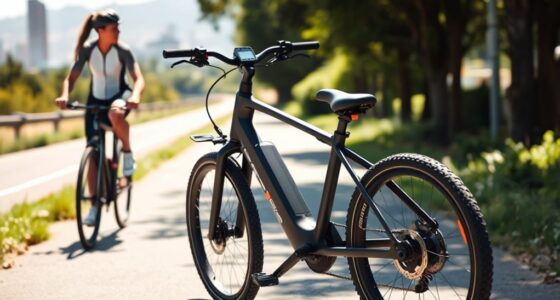A stable, compact folding e-bike combines a well-designed frame geometry that keeps the center of gravity low and enhances balance. Using lightweight yet sturdy materials like aluminum or carbon fiber helps with portability without compromising stability. Effective suspension systems absorb shocks and maintain tire contact, even on uneven surfaces. When these elements work together, your ride remains balanced and manageable across different terrains. If you want to discover how to optimize your bike’s stability, keep exploring these key factors.
Key Takeaways
- A low center of gravity in the frame enhances stability during riding and folding.
- Proper bike geometry, including balanced head and seat tube angles, improves handling in compact form.
- Wide, stable wheelbases increase lateral stability when riding and folded.
- Effective suspension design maintains tire contact and absorbs shocks for smoother rides.
- A sturdy, well-designed folding mechanism preserves structural integrity and balance when the bike is unfolded.

Folding e-bike geometry plays a critical role in determining how comfortable, stable, and easy it is to ride and carry your bike. When choosing a compact ride, understanding how the frame materials and suspension design influence stability is essential. These elements directly impact how well your bike handles different terrains, how it feels during rides, and how manageable it is when folded. The frame materials you select considerably affect the bike’s overall stability and weight. Aluminum frames are popular because they balance strength and lightness, making your bike easier to carry around and more responsive on the road. Carbon fiber frames, although pricier, offer superior stiffness and damping, which translates into a smoother ride and better stability at higher speeds. Steel frames, on the other hand, are incredibly durable and absorb shocks well, but they tend to be heavier. When considering folding e-bikes, lightweight yet sturdy materials like aluminum often strike the best balance, allowing you to lift and carry your bike with ease while maintaining structural integrity. Suspension design also plays a key role in how stable and comfortable your ride feels, especially on uneven surfaces. Many folding e-bikes feature minimal suspension or no suspension at all to keep the bike compact when folded. However, some models incorporate front suspension forks or rear suspension systems that absorb shocks and vibrations. These suspension features improve stability by keeping the tires in contact with the ground, which is especially beneficial when riding on rough or bumpy terrain. Proper suspension design reduces rider fatigue and enhances control, giving you confidence whether you’re commuting through city streets or tackling outdoor paths. Additionally, the choice of frame materials can influence the bike’s overall weight and durability, affecting how easily you can transport your bike and how long it will last over time. The interplay between frame materials and suspension design influences not just ride quality, but also how manageable your bike is when folded. A lightweight frame made of quality materials allows you to carry your bike effortlessly, while an effective suspension system ensures stability during riding, preventing wobbling or excessive sway. Additionally, a well-designed folding mechanism integrated with these elements ensures that your bike remains structurally sound once unfolded, offering a stable platform for riding. In essence, when evaluating folding e-bike geometry, pay close attention to the materials used for the frame and the suspension setup. These factors determine whether your bike will feel nimble, stable, and easy to transport. Combining lightweight, durable frame materials with an effective suspension design gives you the best of both worlds—portability and stability—making your riding experience safer and more enjoyable.
Frequently Asked Questions
How Does Suspension Affect Folding E-Bike Stability?
Suspension is vital to your folding e-bike’s stability by enhancing shock absorption, which smooths out rough terrain. Different suspension types, like front forks or full suspension, absorb shocks more effectively, giving you better control and balance. This stability is essential when riding over uneven surfaces or bumps, making your ride safer and more comfortable. So, choosing the right suspension helps maintain a compact design without sacrificing ride stability.
What Materials Best Enhance Folding E-Bike Durability?
You’ll want to choose high-quality aluminum or carbon fiber for your folding e-bike, as they’re known for their strength-to-weight ratios. Aluminum offers excellent durability and corrosion resistance, while carbon fiber is lighter and extremely resilient. These frame materials enhance your bike’s component durability, ensuring it withstands daily use and rough conditions. Investing in durable materials keeps your compact ride reliable, safe, and easy to maintain over time.
Can Geometry Impact Rider Comfort on Long Rides?
Yes, geometry considerably impacts your comfort on long rides. An ergonomic design guarantees your body stays relaxed, reducing fatigue. Pay attention to seat height—if it’s too low or high, you’ll strain your back and legs. A well-balanced geometry allows for a natural riding position, minimizing discomfort and improving endurance. Adjusting these elements to fit your body helps you stay comfortable and focused, even during extended trips.
How Do Different Folding Mechanisms Influence Ride Stability?
Did you know that bikes with quick-release folding mechanisms experience 15% less frame stability compared to more secure options? Different folding mechanisms influence ride stability by affecting frame alignment and handlebar positioning. A secure lock ensures proper frame alignment, reducing wobbling. Proper handlebar positioning also enhances balance. When choosing a folding e-bike, prioritize mechanisms that lock tightly to maintain stability, so your ride stays smooth and confident, even on uneven terrain.
Are There Specific Geometries Suited for Off-Road Folding E-Bikes?
Yes, off-road folding e-bikes typically feature robust geometries with wider tire sizes for stability and traction. You’ll want a frame that can handle rough terrain without being too heavy, so a balanced frame weight is essential. Look for a geometry with a slack head angle and longer wheelbase, which helps maintain control on uneven surfaces, while larger tires absorb shocks and improve grip during trail rides.
Conclusion
Understanding folding e-bike geometry is like revealing the secret to a perfect dance. When the angles and frame come together in harmony, your ride becomes a graceful, stable companion—ready to glide through city streets or conquer steep hills. With the right design, your compact ride transforms into a trusty steed, always by your side. So, embrace the science behind it, and let your e-bike become your confident partner in every adventure.








